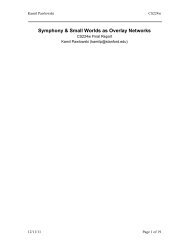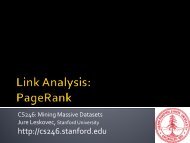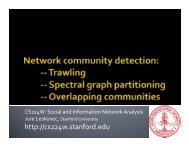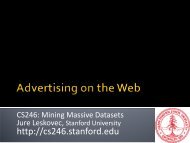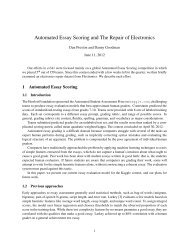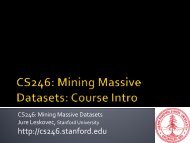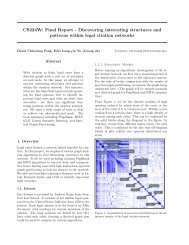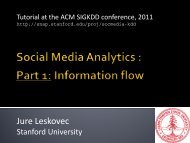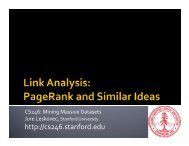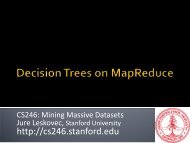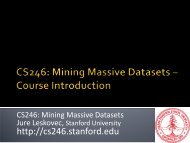Slides - SNAP - Stanford University
Slides - SNAP - Stanford University
Slides - SNAP - Stanford University
Create successful ePaper yourself
Turn your PDF publications into a flip-book with our unique Google optimized e-Paper software.
CS224W: Social and Information Network Analysis<br />
Jure Leskovec, <strong>Stanford</strong> <strong>University</strong><br />
http://cs224w.stanford.edu
We are surrounded by hopelessly complex<br />
systems:<br />
Society is a collection of six billion individuals<br />
Communication systems link electronic devices<br />
Information and knowledge is organized and linked<br />
Thousands of genes in our cells work together in a<br />
seamless fashion<br />
Our thoughts are hidden in the connections<br />
between billions of neurons in our brain<br />
These systems, random looking at first, display<br />
signatures of order and self-organization<br />
9/27/2011 Jure Leskovec, <strong>Stanford</strong> CS224W: Social and Information Network Analysis 2
Each such system can be represented as a<br />
network, that defines the interactions<br />
between the components<br />
9/27/2011 Jure Leskovec, <strong>Stanford</strong> CS224W: Social and Information Network Analysis 3
Graph of the Internet<br />
(Autonomous Systems)<br />
9/27/2011 Jure Leskovec, <strong>Stanford</strong> CS224W: Social and Information Network Analysis 4
Connections between political blogs<br />
9/27/2011 Jure Leskovec, <strong>Stanford</strong> CS224W: Social and Information Network Analysis 5
Seven Bridges of Königsberg<br />
(Euler 1735)<br />
Return to the starting point by traveling each<br />
link of the graph once and only once.<br />
London Underground<br />
9/27/2011 Jure Leskovec, <strong>Stanford</strong> CS224W: Social and Information Network Analysis 6
: departments<br />
: consultants<br />
: external experts<br />
9/27/2011 Jure Leskovec, <strong>Stanford</strong> CS224W: Social and Information Network Analysis 7
Bio-tech companies, 1991<br />
Nodes:<br />
Companies<br />
Investment<br />
Pharma<br />
Research Labs<br />
Public<br />
Biotechnology<br />
Links:<br />
Collaborations<br />
Financial<br />
9/27/2011 Jure Leskovec, <strong>Stanford</strong> CS224W: Social and Information Network Analysis 8<br />
R&D
Human brain has between<br />
10-100 billion neurons<br />
9/27/2011 Jure Leskovec, <strong>Stanford</strong> CS224W: Social and Information Network Analysis 9
Protein-Protein Interaction Networks:<br />
Nodes: Proteins<br />
Edges: ‘physical’ interactoins<br />
Metabolic networks:<br />
Nodes: Metabolites and enzymes<br />
Edges: Chemical reactions<br />
9/27/2011 Jure Leskovec, <strong>Stanford</strong> CS224W: Social and Information Network Analysis 10
Behind each such system there is an<br />
intricate wiring diagram, a network, that<br />
defines the interactions between the<br />
components<br />
We will never understand a complex<br />
system unless we understand the<br />
networks behind it<br />
9/27/2011 Jure Leskovec, <strong>Stanford</strong> CS224W: Social and Information Network Analysis 11
How do we reason about networks<br />
Empirical: Study network data to find organizational<br />
principles<br />
Mathematical models: Probabilistic, graph theory<br />
Algorithms for analyzing graphs<br />
What do we hope to achieve from models of<br />
networks?<br />
Patterns and statistical properties of network data<br />
Design principles and models<br />
Understand why networks are organized the way they<br />
are (Predict behavior of networked systems)<br />
9/27/2011 Jure Leskovec, <strong>Stanford</strong> CS224W: Social and Information Network Analysis 12
What do we study in networks?<br />
Structure and evolution:<br />
What is the structure of a network?<br />
Why and how did it became to have<br />
such structure?<br />
Processes and dynamics:<br />
Networks provide “skeleton”<br />
for spreading of information,<br />
behavior, diseases<br />
9/27/2011 Jure Leskovec, <strong>Stanford</strong> CS224W: Social and Information Network Analysis 13
Age and size of networks<br />
9/27/2011 Jure Leskovec, <strong>Stanford</strong> CS224W: Social and Information Network Analysis 14
9/27/2011 Jure Leskovec, <strong>Stanford</strong> CS224W: Social and Information Network Analysis 15
9/27/2011 Jure Leskovec, <strong>Stanford</strong> CS224W: Social and Information Network Analysis 16
Why is the role of networks expanding?<br />
Data availability<br />
Rise of the Web 2.0 and Social media<br />
Universality<br />
Networks from various domains of science, nature,<br />
and technology are more similar than one would<br />
expect<br />
Shared vocabulary between fields<br />
Computer Science, Social science, Physics,<br />
Economics, Statistics, Biology<br />
9/27/2011 Jure Leskovec, <strong>Stanford</strong> CS224W: Social and Information Network Analysis 17
9/27/2011 Jure Leskovec, <strong>Stanford</strong> CS224W: Social and Information Network Analysis 18
Intelligence and fighting (cyber) terrorism<br />
9/27/2011 Jure Leskovec, <strong>Stanford</strong> CS224W: Social and Information Network Analysis 19
Predicting epidemics<br />
Real Predicted<br />
9/27/2011 Jure Leskovec, <strong>Stanford</strong> CS224W: Social and Information Network Analysis 20
Interactions of human disease<br />
Drug design<br />
9/27/2011 Jure Leskovec, <strong>Stanford</strong> CS224W: Social and Information Network Analysis 21
If you were to understand the spread of<br />
diseases, can you do it without networks?<br />
If you were to understand the WWW<br />
structure and information, hopeless without<br />
invoking the Web’s topology.<br />
If you want to understand human diseases, it<br />
is hopeless without considering the wiring<br />
diagram of the cell.<br />
9/27/2011 Jure Leskovec, <strong>Stanford</strong> CS224W: Social and Information Network Analysis 22
Covers a wide range of network analysis<br />
techniques – from basic to state-of-the-art<br />
You will learn about things you heard about:<br />
Six degrees of separation, small-world, page rank, network effects, P2P<br />
networks, network evolution, spectral graph theory, virus propagation,<br />
link prediction, power-laws, scale free networks, core-periphery,<br />
network communities, hubs and authorities, bipartite cores,<br />
information cascades, influence maximization, …<br />
Covers algorithms, theory and applications<br />
It’s going to be fun <br />
9/27/2011 Jure Leskovec, <strong>Stanford</strong> CS224W: Social and Information Network Analysis 24
Good background in:<br />
Algorithms<br />
Graph theory<br />
Probability and Statistics<br />
Linear algebra<br />
Programming:<br />
You should be able to write non-trivial programs<br />
4 recitation sessions:<br />
2 to review basic mathematical concepts<br />
2 to review programming tools (<strong>SNAP</strong>, NetworkX)<br />
9/27/2011 Jure Leskovec, <strong>Stanford</strong> CS224W: Social and Information Network Analysis 25
Course website:<br />
http://cs224w.stanford.edu<br />
<strong>Slides</strong> posted at least 30 min before the class<br />
Required readings:<br />
Mostly chapters from Easley&Kleinberg book<br />
Papers<br />
Optional readings:<br />
Papers and pointers to additional literature<br />
This will be very useful for reaction paper and<br />
project proposal<br />
9/27/2011 Jure Leskovec, <strong>Stanford</strong> CS224W: Social and Information Network Analysis 26
Recommended textbook:<br />
D. Easley, J. Kleinberg: Networks, Crowds,<br />
and Markets: Reasoning About a Highly<br />
Connected World<br />
Freely available at:<br />
http://www.cs.cornell.edu/home/kleinber/networks-book/<br />
Optional books:<br />
Matthew Jackson: Social and Economic<br />
Networks<br />
Mark Newman: Networks: An introduction<br />
9/27/2011 Jure Leskovec, <strong>Stanford</strong> CS224W: Social and Information Network Analysis 27
Assignment Due on<br />
Homework 1 October 13<br />
Reaction paper October 20<br />
Project proposal October 27<br />
Homework 2 November 3<br />
Competition November 10<br />
Project milestone November 17<br />
Project write-up<br />
Project poster<br />
presentation<br />
December 11<br />
(no late days!)<br />
December 16<br />
12:15-3;15pm<br />
9/27/2011 Jure Leskovec, <strong>Stanford</strong> CS224W: Social and Information Network Analysis 28
Final grade will be composed of:<br />
2 homeworks: 15% each<br />
Reaction paper: 10%<br />
Substantial class project: 60%<br />
Proposal: 15%<br />
Project milestone: 15%<br />
Final report: 60%<br />
Poster session: 10%<br />
9/27/2011 Jure Leskovec, <strong>Stanford</strong> CS224W: Social and Information Network Analysis 29
Assignments (homeworks, write-ups, reports)<br />
take time. Start early!<br />
How to submit?<br />
Paper: Box outside the class and in Gates basement<br />
We will grade on paper!<br />
You should also submit electronic copy:<br />
1 PDF/ZIP file (writeups, experimental results, code)<br />
Submission website: http://www.stanford.edu/class/cs224w/submit/<br />
SCPD: Only submit electronic copy & send us email<br />
7 late days for the quarter:<br />
Max 4 late days per assignment<br />
9/27/2011 Jure Leskovec, <strong>Stanford</strong> CS224W: Social and Information Network Analysis 30
Substantial course project:<br />
Experimental evaluation of algorithms and models<br />
on an interesting network dataset<br />
A theoretical project that considers a model, an<br />
algorithm and derives a rigorous result about it<br />
An in-depth critical survey of one of the course<br />
topics and offering a novel perspective on the area<br />
Performed in groups of (exactly) 3 students<br />
Project is the main work for the class<br />
9/27/2011 Jure Leskovec, <strong>Stanford</strong> CS224W: Social and Information Network Analysis 31
Borja Peleato (head TA)<br />
Evan Rosen<br />
Chenguang Zhu<br />
Dakan Wang<br />
9/27/2011 Jure Leskovec, <strong>Stanford</strong> CS224W: Social and Information Network Analysis 32
Piazza Q&A website:<br />
http://piazza.com/stanford/fall2011/cs224w<br />
If you don’t have @stanford.edu email address, send us<br />
email and we will register you to Piazza<br />
For e-mailing course staff, always use:<br />
cs224w-aut1112-staff@lists.stanford.edu<br />
For course announcements subscribe to:<br />
cs224w-aut1112-all@lists.stanford.edu<br />
9/27/2011 Jure Leskovec, <strong>Stanford</strong> CS224W: Social and Information Network Analysis 33
You are welcome to sit-in and audit<br />
the class<br />
Please send us email saying that you will be<br />
auditing the class<br />
To receive announcements, subscribe to<br />
the mailing list:<br />
cs224w-aut1112-all@lists.stanford.edu<br />
9/27/2011 Jure Leskovec, <strong>Stanford</strong> CS224W: Social and Information Network Analysis 34
Network is a collection of objects where some<br />
pairs of objects are connected by links<br />
What is the structure of the network?<br />
9/27/2011 Jure Leskovec, <strong>Stanford</strong> CS224W: Social and Information Network Analysis 36
Objects: nodes, vertices N<br />
Interactions: links, edges E<br />
System: network, graph G(N,E)<br />
9/27/2011 Jure Leskovec, <strong>Stanford</strong> CS224W: Social and Information Network Analysis 37
Network often refers to real systems<br />
Web, Social network, Metabolic network<br />
Language: Network, node, link<br />
Graph: mathematical representation of a<br />
network<br />
Web graph, Social graph (a Facebook term)<br />
Language: Graph, vertex, edge<br />
We will try to make this distinction whenever it is appropriate, but in<br />
most cases we will use the two terms interchangeably<br />
9/27/2011 Jure Leskovec, <strong>Stanford</strong> CS224W: Social and Information Network Analysis 38
Actor 1<br />
Movie 2<br />
Protein 1<br />
Protein 9<br />
Actor 3<br />
Movie 1<br />
Protein 2<br />
Actor 2<br />
Movie 3<br />
Protein 5<br />
Actor 4<br />
Peter<br />
brothers<br />
|N|=4<br />
|E|=4<br />
Albert<br />
Mary<br />
co-worker<br />
Albert<br />
9/27/2011 Jure Leskovec, <strong>Stanford</strong> CS224W: Social and Information Network Analysis 39<br />
friend<br />
friend
Choice of the proper network representation<br />
determines our ability to use networks<br />
successfully:<br />
In some cases there is a unique, unambiguous<br />
representation<br />
In other cases, the representation is by no means<br />
unique<br />
The way you assign links will determine the nature<br />
of the question you can study<br />
9/27/2011 Jure Leskovec, <strong>Stanford</strong> CS224W: Social and Information Network Analysis 40
If you connect individuals that work<br />
with each other, you will explore a<br />
professional network<br />
If you connect those that have a<br />
sexual relationship, you will be<br />
exploring sexual networks<br />
If you connect scientific papers<br />
that cite each other, you will be<br />
studying the citation network<br />
If you connect all papers with the same word in the title,<br />
you will be exploring what? It is a network, nevertheless<br />
9/27/2011 Jure Leskovec, <strong>Stanford</strong> CS224W: Social and Information Network Analysis 41
Undirected<br />
Links: undirected<br />
(symmetrical)<br />
B<br />
A<br />
C<br />
D<br />
Undirected links:<br />
L<br />
F<br />
Collaborations<br />
Friendship on Facebook<br />
G<br />
H<br />
M<br />
I<br />
Directed<br />
Links: directed<br />
(arcs)<br />
Directed links:<br />
Phone calls<br />
Following on Twitter<br />
9/27/2011 Jure Leskovec, <strong>Stanford</strong> CS224W: Social and Information Network Analysis 42<br />
A<br />
B<br />
G<br />
C<br />
D<br />
F<br />
E
Connected (undirected) graph:<br />
Any two vertices can be joined by a path.<br />
A disconnected graph is made up by two or<br />
more connected components<br />
D<br />
F<br />
G<br />
A<br />
B<br />
F<br />
C<br />
D<br />
Largest Component:<br />
Giant Component<br />
Isolated node (F)<br />
Bridge edge: If we erase it, the graph becomes disconnected.<br />
Articulation point: If we erase it, the graph becomes disconnected.<br />
9/27/2011 Jure Leskovec, <strong>Stanford</strong> CS224W: Social and Information Network Analysis 43<br />
F<br />
G<br />
A<br />
B<br />
F<br />
C
Strongly connected directed graph<br />
has a path from each node to every other node<br />
and vice versa (e.g., A-B path and B-A path)<br />
Weakly connected directed graph<br />
is connected if we disregard the edge directions<br />
E<br />
D<br />
A<br />
B<br />
C<br />
G<br />
F<br />
Graph on the left is not strongly<br />
connected.<br />
9/27/2011 Jure Leskovec, <strong>Stanford</strong> CS224W: Social and Information Network Analysis 44
Q: What does Web “look like” at a global level?<br />
Web as a graph:<br />
Nodes = pages<br />
Edges = hyperlinks<br />
What is a node?<br />
Problems:<br />
Dynamic pages created on the fly<br />
“dark matter” – inaccessible<br />
database generated pages<br />
9/27/2011 Jure Leskovec, <strong>Stanford</strong> CS224W: Social and Information Network Analysis 45
I teach a<br />
class on<br />
Networks.<br />
CS224W:<br />
Classes are<br />
in the<br />
Computer<br />
Science<br />
building<br />
Computer<br />
Science<br />
Department<br />
at <strong>Stanford</strong><br />
<strong>Stanford</strong><br />
<strong>University</strong><br />
9/27/2011 Jure Leskovec, <strong>Stanford</strong> CS224W: Social and Information Network Analysis 46
I teach a<br />
class on<br />
Networks.<br />
CS224W:<br />
Classes are<br />
in the<br />
Computer<br />
Science<br />
building<br />
Computer<br />
Science<br />
Department<br />
at <strong>Stanford</strong><br />
<strong>Stanford</strong><br />
<strong>University</strong><br />
In early days of the Web links were navigational<br />
Today many links are transactional<br />
9/27/2011 Jure Leskovec, <strong>Stanford</strong> CS224W: Social and Information Network Analysis 47
Citations References in an Encyclopedia<br />
9/27/2011 Jure Leskovec, <strong>Stanford</strong> CS224W: Social and Information Network Analysis 48
9/27/2011 Jure Leskovec, <strong>Stanford</strong> CS224W: Social and Information Network Analysis 49
How is the Web linked?<br />
What is the “map” of the Web?<br />
Web as a directed graph [Broder et al. 2000]:<br />
Given node v, what can v reach?<br />
What other nodes can reach v?<br />
E<br />
D<br />
A<br />
In(v) = {w | w can reach v}<br />
Out(v) = {w | v can reach w}<br />
B<br />
C<br />
9/27/2011 Jure Leskovec, <strong>Stanford</strong> CS224W: Social and Information Network Analysis 50<br />
G<br />
F<br />
In(A) = {B,C,E,G}<br />
Out(A)={B,C,D,F}
Two types of directed graphs:<br />
Strongly connected:<br />
Any node can reach any node<br />
via a directed path<br />
In(A)=Out(A)={A,B,C,D,E}<br />
DAG – Directed Acyclic Graph:<br />
Has no cycles: if u can reach v,<br />
then v can not reach u<br />
Any directed graph can be<br />
expressed in terms of these two types<br />
9/27/2011 Jure Leskovec, <strong>Stanford</strong> CS224W: Social and Information Network Analysis 51<br />
E<br />
E<br />
D<br />
D<br />
A<br />
A<br />
B<br />
C<br />
B<br />
C
Strongly connected component (SCC) is a set<br />
of nodes S so that:<br />
Every pair of nodes in S can reach each other<br />
There is no larger set containing S with this<br />
property<br />
E<br />
D<br />
A<br />
B<br />
C<br />
9/27/2011 Jure Leskovec, <strong>Stanford</strong> CS224W: Social and Information Network Analysis 52<br />
G<br />
F<br />
Strongly connected<br />
components of the graph:<br />
{A,B,C,G}, {D}, {E}, {F}
Fact: Every directed graph is a DAG on its SCCs<br />
(1) SCCs partitions the nodes of G<br />
Each node is in exactly one SCC<br />
(2) If we build a graph G’ whose nodes are SCCs, and<br />
with an edge between nodes of G’ if there is an edge<br />
between corresponding SCCs in G, then G’ is a DAG<br />
G<br />
E<br />
D<br />
A<br />
B<br />
C<br />
G<br />
F<br />
(1) Strongly connected components<br />
of graph G: {A,B,C,G}, {D}, {E}, {F}<br />
(2) G’ is a DAG:<br />
9/27/2011 Jure Leskovec, <strong>Stanford</strong> CS224W: Social and Information Network Analysis 53<br />
{E}<br />
{D}<br />
{A,B,C,G}<br />
{F}<br />
G’
Why is (1) true? SCCs partitions the nodes of G.<br />
Suppose node v is a member of 2 SCCs S and S’.<br />
Then S∪S’ is one large SCC:<br />
S<br />
Why is (2) true? G’ (graph of SCCs) is a DAG<br />
If G’ is not a DAG, then we have a<br />
directed cycle.<br />
Now all nodes on the cycle are<br />
mutually reachable, and all are<br />
part of the same SCC.<br />
v<br />
9/27/2011 Jure Leskovec, <strong>Stanford</strong> CS224W: Social and Information Network Analysis 54<br />
S’<br />
{E}<br />
{D}<br />
{A,B,C,G}<br />
G’<br />
{F}<br />
Now {A,B,C,G,E,F} is a SCC
Take a large snapshot of the Web and try to<br />
understand how it’s SCCs “fit together” as a<br />
DAG<br />
v<br />
Computational issue:<br />
Want to find SCC containing node v?<br />
Observation:<br />
Out(v)<br />
Out(v) … nodes that can be reached from v<br />
SCC containing v is: Out(v) ∩ In(v)<br />
= Out(v,G) ∩ Out(v,G), where G is G with all edge directions flipped<br />
9/27/2011 Jure Leskovec, <strong>Stanford</strong> CS224W: Social and Information Network Analysis 55
There is a giant SCC<br />
There won’t be 2 giant SCCs:<br />
Just takes 1 page from one SCC to link to the<br />
other SCC<br />
If the components have millions of pages the<br />
likelihood of this is very large<br />
Giant SCC1 Giant SCC2<br />
[Broder et al., ‘00]<br />
9/27/2011 Jure Leskovec, <strong>Stanford</strong> CS224W: Social and Information Network Analysis 56
250 million pages, 1.5 billion links<br />
[Broder et al., ‘00]<br />
9/27/2011 Jure Leskovec, <strong>Stanford</strong> CS224W: Social and Information Network Analysis 57
Learn:<br />
Some conceptual organization of the Web (i.e., bowtie)<br />
Not learn:<br />
Treats all pages as equal<br />
Google’s homepage == my homepage<br />
What are the most important pages<br />
How many pages have k in-links as a function of k?<br />
The degree distribution: ~1/k 2+ε<br />
Link analysis ranking -- as done by search engines (PageRank)<br />
Internal structure inside giant SCC<br />
Clusters, implicit communities?<br />
How far apart are nodes in the giant SCC:<br />
Distance = # of edges in shortest path<br />
Avg = 16 [Broder et al.]<br />
9/27/2011 Jure Leskovec, <strong>Stanford</strong> CS224W: Social and Information Network Analysis 58



